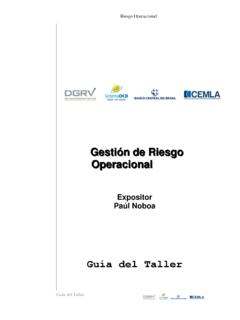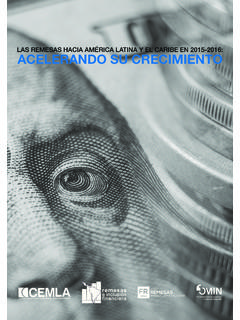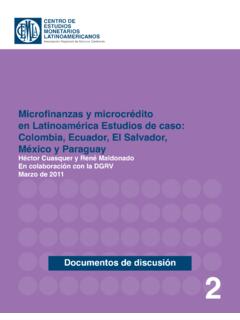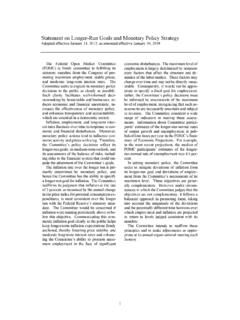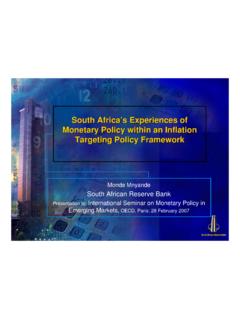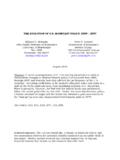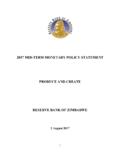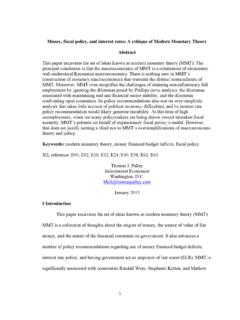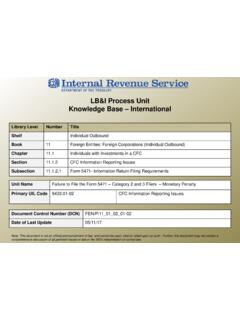Transcription of Structural Changes in the Transmission Mechanism …
1 Structural Changes in the Transmission Mechanism of monetary policy in Mexico: A Non-linear VAR Approach * Alejandro Gaytan Gonz lez Jesus R. Gonzalez-Garcia April, 2006 Working Paper 2006-06 Direcci n General de Investigaci n Econ mica Banco de M xico * We thank Daniel Chiquiar, Manuel Ramos-Francia and Alberto Torres for very helpful comments and Edgar Hern ndez and Lorenzo Bernal for excellent research assistance. The opinions in this paper correspond to the authors and do not necessarily reflect the point of view of Banco de M xico or the IMF. Direcci n General de Investigaci n Econ mica, Banco de M xico. Statistics Department, International monetary Fund. Structural Changes in the Transmission Mechanism of monetary policy in Mexico: A Non-linear VAR Approach Alejandro Gaytan Jesus R. Gonzalez-Garcia April, 2006 Working Paper 2006-06 Direcci n General de Investigaci n Econ mica Banco de M xico Abstract.
2 In this paper we present a first approach to the study of the transformation in the Transmission Mechanism of monetary policy that has taken place in Mexico in recent years. For this purpose, we use a non-linear VAR model that allows for regime shifts. The comparison of the different regimes identified leads to the following main findings: a) there was a major Structural change in the Transmission Mechanism around January 2001, date that coincides with the formal adoption of the inflation targeting framework; b) after this change , fluctuations in the real exchange rate have had smaller effects on the process of price formation, the formation of inflation expectations and the nominal interest rate; c) also, there have been stronger reactions of the nominal interest rate to increases in the output gap and the rate of inflation; and d) the movements of the nominal interest rate have a more effective influence on the real exchange rate and the rate of inflation.
3 JEL: E52, E58 and F33. Keywords: monetary policy , Mexico, monetary Transmission Mechanism , non-linear models. Resumen. Este documento de trabajo presenta un primer acercamiento al estudio de las transformaciones que han tenido lugar en el mecanismo de transmisi n de la pol tica monetaria en M xico en a os recientes. Para este fin, se utiliza un modelo no lineal de vectores autorregresivos que permite cambios de r gimen. La comparaci n de los diferentes reg menes identificados sugiere los siguientes resultados principales: a) se observ un importante cambio estructural en el mecanismo de transmisi n alrededor de enero de 2001, fecha que coincide con la adopci n formal del esquema de objetivos de inflaci n; b) despu s de este cambio, las fluctuaciones del tipo de cambio real han tenido un efecto menor sobre los procesos de formaci n de precios y de expectativas de inflaci n y sobre la tasa de inter s nominal; c) adicionalmente, se ha incrementado la reacci n de la tasa de inter s nominal ante incrementos en la brecha del producto y la tasa de inflaci n; y d) los movimientos en la tasa de inter s nominal tienen una influencia m s efectiva sobre el tipo de cambio real y la tasa de inflaci n.
4 1 IntroductionAfter the currency andfinancial crisis of 1995, monetary policy in M xico has been devotedto pursue the objective of long-run price stability, which has resulted in a major change inthe inflationary process. As can be observed in Figure 1, the monthly rates of core inflationhave shown a decreasing trajectory, despite the increases observed in 1998 after the crises inemerging Asia and Russia, and its consequences in factors, both domestic and external can help to explain the reduction of inflationrates in the last 10 years. In the domestic front, we can highlight among the most important,theeconomicpoliciesthatprevent edafiscal dominance situation in the aftermath of thecurrency andfinancial crisis of 1995; several institutional Changes , as thefloating exchangerate regime at work; and the gradual adoption of the inflation targeting framework for theconduct of monetary policy , which led to the announcement of its definitive adoption at thebeginning of 1: Core Inflation (monthly rate in percent)0%1%2%3%4%5%6%7%8%1990 1991 1992 1993 1994 1995 1996 1997 1998 1999 2000 2001 2002 2003 2004 20051In this paper we present afirst approach to the study of one aspect of the Changes inthe inflationary process in Mexico, namely, the identification by means of empirical methodsof the Changes that have occurred in the Transmission Mechanism of monetary policy .
5 Thisexploration sheds light on the underlying causes of the success observed in the reductionof inflation in recent years and the role played by the profound Changes observed in theimplementation of monetary identify possible Changes in the Transmission Mechanism of monetary policy we usea Markov-switching vector autoregressive (MS-VAR) methodology in order to determine thedates of the Structural Changes and to study how the dynamic relationships of the main macro-economic variables have changed over time. First, we estimate a linear vector autoregression(VAR) model including the following endogenousvariables: the real exchange rate, the outputgap, the rate of inflation, the expected rate of inflation and the nominal interest rate. Aftershowing that the linear estimation shows considerable parameter instability, we estimate anMS-VAR that allows for Changes in the parameters over time. The non-linear estimation withregime shifts allows an endogenous identification of different regimes over time according tothe Changes in the parameters of the model, without the need for priors about the dates of thechanges, their direction or magnitude.
6 Finally, in order to characterize the Changes that haveoccurred in the Transmission Mechanism of monetary policy , we assume a simple recursivestructure of the model to identify Structural shocks and present a comparison of the impulseresponse functions and the variance decomposition corresponding to different results of the exercise with regime shifts suggest the following Changes in the trans-mission Mechanism of monetary policy in recent years. There seems to be a major structuralbreak in the Transmission Mechanism at the beginning of 2001, date that coincides with theformal adoption of the inflation targeting framework. After this change ,fluctuations in thereal exchange rate have had smaller effects on the process of price formation and on inflationexpectations. The nominal interest rate has alsoshown a milder reaction to real addition, there is evidence of a stronger reaction of the nominal interest rate to demandpressures, measured by the output gap, and the inflation rate.
7 Finally, the results suggesta stronger response of the real exchange rate and the rate of inflation to movements in theinterest paper is organized as follows. In section 2, we discuss the model estimated. In section3, we present the unit root tests for the series included in the model in order to examinethe possible presence of unit roots. Section 4, presents the estimation of the VAR model in alinear framework and the analysis of its stability properties. In section 5 we estimate the VARallowing for regime shifts. These shifts will allow us to identify the Changes in the transmissionmechanism by comparing the impulse response functions and variance decomposition obtainedfrom the different regimes, assuming a recursive structure of the model. Section 6 summarizesthe results and presents the The monetary Transmission Mechanism and the EstimatedModelSince the work of Sims (1980) VAR models have been the most widely used empirical method-ology to study the Transmission Mechanism of monetary policy ,1mainly because VARs providea systematic way to capture rich dynamic structures and co-movements between different timeseries without restricting for a specific functional use of VARs for the study of the monetary Transmission Mechanism requires someidentifying assumptions to allow for contemporaneous co-movement between the endogenousvariables and to isolate the different shocks to be able, for example, to distinguish betweena monetary shock from a simple surprise movement in the monetary sim-plest form of identification assumptions is to assume a recursive structure of the economy inwhich thefirst variable responds only to lagged values of all endogenous variables, the secondresponds to the same lagged values and the contemporaneous value of thefirst variable, andso on.
8 In this case, the last variable of the system responds to lags and the contemporaneousrealization of all the other endogenous variables. Other approaches derive the identificationfrom different assumptions about the timing of responses of variables or from theoretical mod-1 See for example Bernanke and Blinder (1997), Clarida and Gertler (1997) and Leeper, Sims and Zha (1996).2A VAR with k endogenous variables requires k(k-1) identifying assumptions. A common assumption is toorthogonalize the innovations so that an innovation or shock in one equation of the system is uncorrelated withthe innovations in other equations. These restrictionsprovide half on the identifying assumptions for a justidentified VAR. About the identification assumptions in VAR models see Christiano (2000).3els. VAR models identified in this way are termed Structural vector autoregression (SVAR)models. The identification assumptions may be determined by the short run relations betweenthe variables ( Bernanke and Mihov 1998) or may come in the form of long run restric-tions based on theoretical grounds ( a vertical Phillips curve in the long run, as in Quahand Vahey 1995).
9 In addition, a recent stream of literature on SVAR models, uses minimalrestrictions about the signs and shapes of theresponsesofthevariablestoshocksthatar ealso derived from a theoretical model (Uhlig 2005, Canova and de Nicolo 2002).There are some important criticisms to the use of VAR models to study the monetarytransmission Mechanism : First, there is the question of what is really captured by an identifiedshock. This problem becomes evident when small Changes in the identification assumptions orin the set of endogenous variables included imply important differences in the impulse responsefunctions of a given variable to a specific Structural shock. The most common example of thisproblem is the price puzzle of monetary policy : a predicted increase in inflation following amonetary tightening. The main explanation of this puzzle (Sims 1992) is that when monetarypolicy is forward looking, and the VAR model has as a poor account of inflation expectations,an increase in the nominal interest rate coming from inflation expectations may end up beingattributed to a policy second criticism is related to the stability and linearity of VAR models.
10 There aretwo main issues concerning these problems when the VAR methodology is used to study aneconomy that has experienced periods of instability and policy Changes . First, there may beimportant policy regime Changes , as Changes in the monetary policy rule over time, and ifthese Changes affect the process of expectation formation, the coefficients of the model willchange vis- -vis the rule. In addition, in some emerging economiesfinancial crises episodesmay imply an increase in the variance of shocks, exceptional responses of monetary policyand, in some cases, the abandonment of previous monetary policy rules. These are somereasons why linear VAR estimations for countries like Mexico usually have severe difficultiesin delivering reasonable third criticism is related with the Structural restrictions used for identification. Recur-3 Sims and Zha (1995) show that including variables likecommodity prices, which contain information aboutinflationary pressures, helps to solve the price and short run restrictions depend on particular timing assumptions: if these assumptionsare not accurate because of misspecification or because they do not hold over the frequencyof the data used for the estimation, the identified structure may be just summarizing cor-relations in the data.



